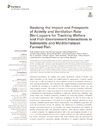Please use this identifier to cite or link to this item:
https://accedacris.ulpgc.es/jspui/handle/10553/114404
| Título: | Revising the Impact and Prospects of Activity and Ventilation Rate Bio-Loggers for Tracking Welfare and Fish-Environment Interactions in Salmonids and Mediterranean Farmed Fish | Autores/as: | Calduch-Giner, Josep Holhorea, Paul George Ferrer Ballester, Miguel Ángel Naya-Català, Fernando Rosell-Moll, Enrique Vega García, Carlos Prunet, Patrick Espmark, Asa M. Leguen, Isabelle Kolarevic, Jelena Vega Martínez, Aurelio Kerneis, Thierry Goardon, Lionel Afonso López, Juan Manuel Pérez-Sánchez, Jaume |
Clasificación UNESCO: | 310502 Piscicultura 240102 Comportamiento animal |
Palabras clave: | Activity patterns Bio-loggers Fish behavior Fish robustness Ventilation rate, et al. |
Fecha de publicación: | 2022 | Proyectos: | AQUAculture infrastructures for EXCELlence in EUropean fish research 3.0 | Publicación seriada: | Frontiers in Marine Science | Resumen: | Behavioral parameters are reliable and useful operational welfare indicators that yield information on fish health and welfare status in aquaculture. However, aquatic environment is still constraining for some solutions based on underwater cameras or echo sounder transmitters. Thus, the use of bio-loggers internally or externally attached to sentinel fish emerges as a solution for fish welfare monitoring in tanks- and sea cages-rearing systems. This review is focused on the recently developed AEFishBIT, a small and light data storage tag designed to be externally attached to fish operculum for individual and simultaneous monitoring of swimming activity and ventilation rates under steady and unsteady swimming conditions for short-term periods. AEFishBIT is a tri-axial accelerometer with a frequency sampling of 50–100 Hz that is able to provide proxy measurements of physical and metabolic activities validated by video recording, exercise tests in swim tunnel respirometers, and differential operculum and body tail movements across fish species with differences in swimming capabilities. Tagging procedures based on tag piercing and surgery procedures are adapted to species anatomical head and operculum features, which allowed trained operators to quickly complete the tagging procedure with a fast post-tagging recovery of just 2.5–7 h in both salmonid (rainbow trout, Atlantic salmon) and non-salmonid (gilthead sea bream, European sea bass) farmed fish. Dual recorded data are processed by on-board algorithms, providing valuable information on adaptive behavior through the productive cycle with the changing environment and genetics. Such biosensing approach also provides valuable information on social behavior in terms of adaptive capacities or changes in daily or seasonal activity, linking respiratory rates with changes in metabolic rates and energy partitioning between growth and physical activity. At short-term, upcoming improvements in device design and accompanying software are envisaged, including energy-harvesting techniques aimed to prolong the battery life and the addition of a gyroscope for the estimation of the spatial distribution of fish movements. Altogether, the measured features of AEFishBIT will assist researchers, fish farmers and breeders to establish stricter welfare criteria, suitable feeding strategies, and to produce more robust and efficient fish in a changing environment, helping to improve fish management and aquaculture profitability. | URI: | https://accedacris.ulpgc.es/handle/10553/114404 | ISSN: | 2296-7745 | DOI: | 10.3389/fmars.2022.854888 | Fuente: | Frontiers in Marine Science [ISSN 2296-7745], v. 9 (854888), (2022) |
| Colección: | Artículos |
Citas SCOPUSTM
9
actualizado el 08-jun-2025
Citas de WEB OF SCIENCETM
Citations
11
actualizado el 08-jun-2025
Visitas
245
actualizado el 15-mar-2025
Descargas
190
actualizado el 15-mar-2025
Google ScholarTM
Verifica
Altmetric
Comparte
Exporta metadatos
Los elementos en ULPGC accedaCRIS están protegidos por derechos de autor con todos los derechos reservados, a menos que se indique lo contrario.
